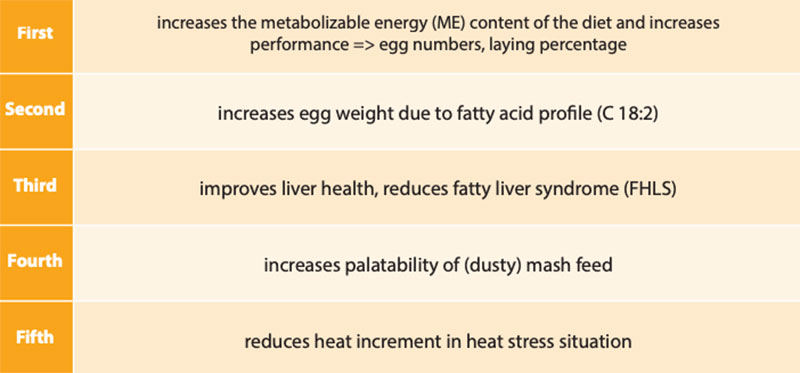Basic knowledge of fat
Fat has nearly 2.5 times more calories than carbohydrates. Fat provides roughly nine calories of energy per gram, while carbohydrates (from corn and other cereals) provide roughly only four. At room temperature, saturated fats are solid in form while unsaturated fats are liquid. Examples of saturated fats used in poultry diets include tallow, lard, poultry fat, palm oil and so-called “greases”. Examples of substances with high levels of unsaturated fats are corn oil, soy bean oil, sunflower oil and rapeseed/canola oil. Fats are composed of smaller compounds called fatty acids. Fatty acids are responsible for cell membrane integrity and hormone synthesis. Although there are many different fatty acids, poultry has a specific requirement for one – linoleic acid (C 18:2) – so it must be included in the diet. Linoleic acid is considered an essential fatty acid because poultry cannot generate it from other nutrients.Why fat in the diet?
Fat must be present in the poultry diet in order to absorb the fatsoluble vitamins A, D, E and K. In addition to its role in nutrition, fat is added to feed to reduce grain dust and to bind the fine particles in the feed (premix, amino acids and minerals) to the coarser particles. Fat also improves the palatability of feed, especially in mash feed. If there is a shortage of fat (fatty acids), the liver, which is the most important organ in the highly prolific layers of today, will have to provide fat and fatty acids for the body metabolism. This is a big challenge for the health of the liver, as the liver needs to provide fatty acids by lipogenesis – basically from carbohydrates. The digestion of protein and carbohydrates as basic sources of energy causes a high level of metabolic heat (heat increment) in comparison to crude fat, which will ultimately reduce daily intake under heat stress circumstances. Therefore, replacing energy provided from carbohydrates with crude fat is a beneficial way of supporting the metabolism of layers in a heat stress situation.Level of crude fat in diets
A crude fat level of at least 5% in layer diets is highly recommended. To achieve this 5%, 2-3% of fat or oil has to be added, even to a corn/soy diet. Higher levels of crude fat and added fat/oil are even more beneficial. The maximum amount is defined more by technical reasons than by nutritional ones, as diets of up to 7.5% of crude fat are excellent for layers. This has been proven in different circumstances and climates all around the world.Robert Pottgueter
Adding fat and oil to layer feed has at least five additional effects with increasing levels of crude fat and added fat/oil:








